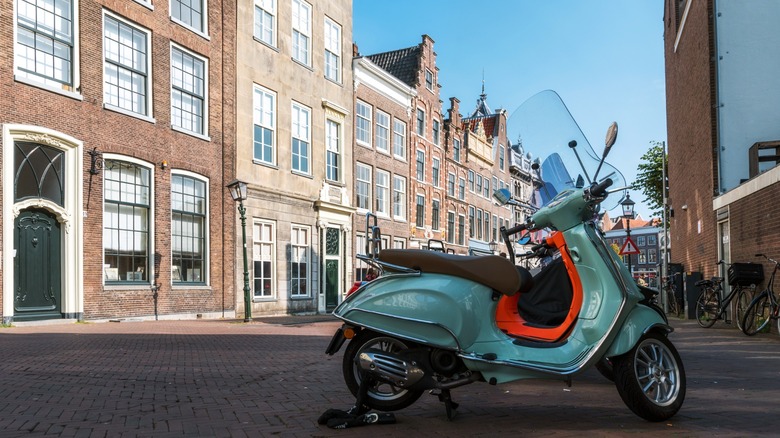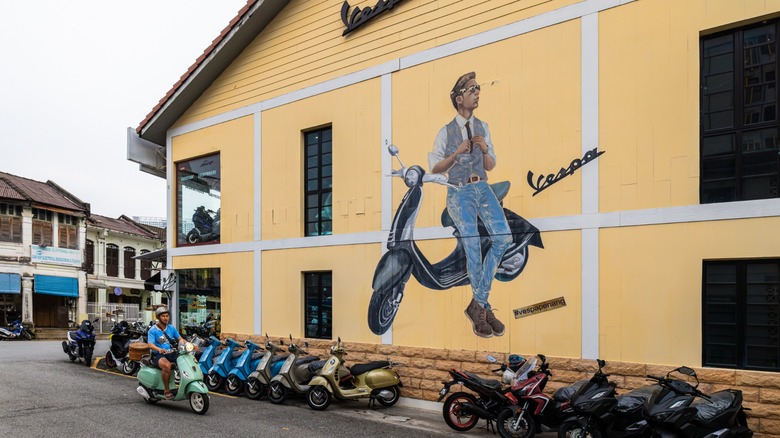Who Owns Vespa, And Where Are The Scooters Made?
Today, Vespa is synonymous with scooters, much like Band-Aid is with bandages or Kleenex with tissues. Rather remarkably, this wildly successful product came from a factory in Pontedera, a small town in Tuscany, Italy. And the company behind it, Piaggio & Co., didn't even start out making vehicles. When Rinaldo Piaggio took over the family business in 1884, they were focused on producing fittings for luxury ships. Under his leadership, Piaggio later pivoted into aviation, building aircraft engines and seaplanes. By the 1930s, it had grown into one of Italy's largest aeronautical companies.
However, that success took a brief pause during World War II, when the Pontedera factory was hit by a bomb. And after the war, the Piaggio family had to rebuild their factory and rethink their entire business model. For Enrico Piaggio, Rinaldo's son, there weren't a lot of options. It was either kitchenware or small vehicles. And that's how they went on to create the iconic Vespa in 1946.
Interestingly, the engineer who designed it, Corradino D'Ascanio, actually disliked motorcycles. He thought they were noisy, dirty, and bulky. His goal was to reimagine the ideal two-wheeler— a simple, clean, and easy-to-ride machine. And for many people today, the Vespa isn't even a motorcycle. Because back then, after the war, fuel was scarce, cars were too expensive, and motorcycles were quite intimidating. There was a clear need for an in-between vehicle: something efficient, affordable, and simple. Decades later, we can look back and say the Vespa filled that gap rather perfectly.
Vespas still roll off the line in Italy
Just a year after its debut, Piaggio was rolling out over 500 Vespas every month, and the numbers have only gone up since then. Over 19 million units have been sold to date. And yes, Vespas are still manufactured in Piaggio's original plant in Pontedera, Italy. But to keep up with global demand, Piaggio also produces scooters in Baramati, India, for the local market and in Vinh Phuc, Vietnam, for Southeast Asia.
Still, the Pontedera facility remains the company's headquarters and home to the Museo Piaggio, the largest Italian museum dedicated to two-wheelers. Inside, visitors can see everything from the very first 1946 Vespa prototype to the model Audrey Hepburn and Gregory Peck rode in the 1953 film Roman Holiday, along with several other limited edition models that followed and shaped pop culture. However, Piaggio is no longer the family-owned business it once was. As the company grew rapidly, it experienced its fair share of ups and downs. In the 1980s, the company briefly pulled out of the U.S. market, leaving customers wondering: what happened to Vespa?
By the 1990s, the company was under significant financial strain and could easily have become one of those classic motorcycle brands that aren't around anymore. But things changed in 2003, when Italian businessman Roberto Colaninno, through his holding company Immsi S.p.A., took over. Under his leadership, Piaggio acquired Aprilia and Moto Guzzi, consolidating into one of Europe's largest motorcycle and scooter manufacturers. In 2006, Piaggio went public on the Italian Stock Exchange. And today, the Colaninno family, through Immsi, holds the largest stake in the company, which is now Piaggio & C. S.p.A.

